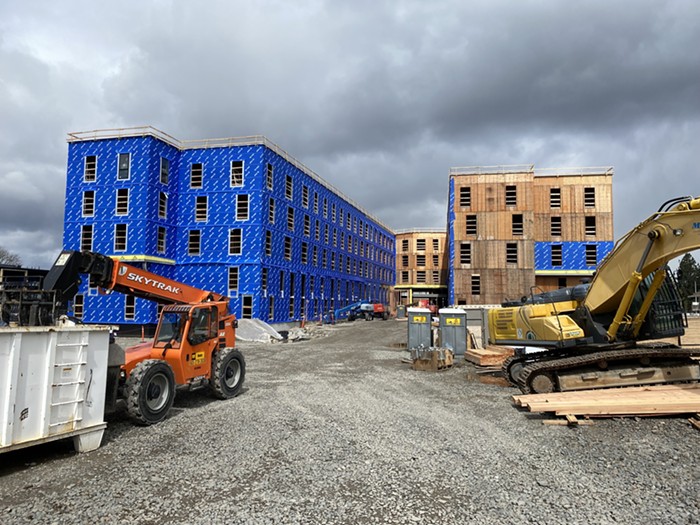IN A YEAR when environmental hazards have screamed across TV news broadcasts with surprising frequency, lead has had a starring role.
Already on alert from disturbing revelations of carcinogens spewing from two Portland glass factories, parents citywide flew into a panic in May, when it suddenly became clear that Portland Public Schools (PPS) wasn’t keeping lead out of their kids’ drinking water.
What often gets lost in this important conversation is that there aren’t records of anyone getting lead poisoning from water in Portland. As PPS hastened to point out earlier this year: “Health department investigations have traced lead poisoning in children in our community to numerous sources including paint, metal scrapping, hobbies, pottery, and a teapot from a yard sale.”
Not water. And that means a bigger cause for concern might well be the backhoe trundling down your street.
As home demolitions reach historic levels in Portland, there are no safeguards against lead dust that can be stirred up when older homes are demolished.
It’s an odd oversight. Federal rules dutifully require safety precautions if those same homes are renovated—rules designed to stop property owners and their neighbors from coming into contact with lead, a neurotoxin for which there is no known safe exposure level.

But when the home is torn down? The lead can fly unchecked, potentially creating problems for soil and nearby neighbors.
“It is kind of a strange loophole,” says Brett Sherry, a manager of regulatory programs at the Oregon Health Authority (OHA), which enforces federal lead safety rules for home remodels. “If you disturb six square feet, these rules apply. If you knock the whole house down, nothing.”
This loophole has been on regulators’ radar for years. There has even been talk of crafting legislation to correct the gap, and a law to do so will be floated in Salem next year.
But it’s so far gone completely unaddressed. And that has potential repercussions for every neighborhood in the city, as demolitions eclipse pre-recession levels.
According to public records obtained by the Mercury, from January 2014 through August 2016, the city fielded applications for nearly 950 demolition permits for homes built in 1977 or before.
That year is important in the context of lead—1978 is the year the federal government banned lead paint. As the US Environmental Protection Agency puts it: “If your home was built before 1978, there is a good chance it has lead-based paint.”
And in Portland recently, a huge number of those homes are being demolished.
Of roughly 973 demolition permits issued or applied for since 2014, 97 percent were for homes built before 1978, according to city records. The demolitions are occurring all over the city, but are especially prominent in Sellwood-Moreland, which has seen 56 demolition applications for these homes since 2014, including at least one property adjacent to a city park.
The Brentwood-Darlington neighborhood had the second-most demolition applications for homes built in 1977 and before, with 38. The Richmond, Montavilla, and Woodstock neighborhoods all had at least 30 applications.
Without any rules in place requiring that lead be addressed, all of these demolitions pose a potential hazard, officials say.
“If you hire someone to knock down a house, it’s probably someone with larger equipment like a bulldozer,” says Sherry. “They’re not certified. They’re not trained. There could be lead dust that could contaminate the ground. You could contaminate neighboring yards.”
The gaping hole in regulation didn’t see widespread coverage until earlier this month, when a group of neighbors began railing against the planned demolition of a home on SE Sherman, which they feared could harm an infant living next door and potentially pollute their soil. (Lead is particularly problematic for young children.)
Kelly Campbell, a neighbor and Executive Director of Oregon Physicians for Social Responsibility, set about calling any agency she could that might be able to force the owners to address lead concerns. The OHA, Oregon Department of Environmental Quality, the state’s Construction Contractors Board—they all came back with the same answer, Campbell says: There were no rules limiting lead exposure for demolitions.
“It’s this huge regulatory loophole, and I don’t know the reasoning behind it,” she says. “It makes no sense.”
At least some help is on the way. Beginning October 31, any home built in 1916 or before will need to be “deconstructed” under new city rules. That means much of the home will need to be dismantled piece by piece, so its components can be reused.
The new law passed through Portland City Council in July, but not only because it would offer safeguards for lead exposure (asbestos was raised repeatedly, along with more generic harmful dust). The law is also seen as a means of discouraging demolition by making razing a home more time-consuming, and a way to keep quality building materials out of the landfill.
Still, it might cut meaningfully into the lead loophole. More than a third of houses that homeowners and developers sought to demolish since 2014 were built in 1916 or before, according to city records.
In the wake of Campbell and her neighbors’ outcry, officials have been coming out of the lead-coated woodwork to offer their opinions.
“I believe there is a real risk for escaping lead dust to come out of these demolition projects,” Perry Cabot, a lead specialist with Multnomah County, told OPB.
State Senator Diane Rosenbaum, who lives nearby, said she was “appalled.”
Meanwhile, State Senator Michael Dembrow says he’ll take a shot at closing the lead loophole in next year’s legislative session. Dembrow’s got some experience on the matter—he sponsored a new law to better regulate asbestos in home demolitions in 2015.
At the time, he said, “We were initially looking at both asbestos and lead. Purely for administrative reasons, we ended up limiting it to asbestos.”
Dembrow says problems arise when figuring out which agency should regulate lead in home demolitions. That’s still not clear, he says. It might be the state Department of Environmental Quality, which regulates asbestos. It might be another entity.
“We feel like we will get to an answer in the next several months,” Dembrow says. “There’s a lot of interest in this.”
EDITOR'S NOTE: This article has been revised to reflect that Portland's deconstruction ordinance was enacted partly with lead dust in mind.














